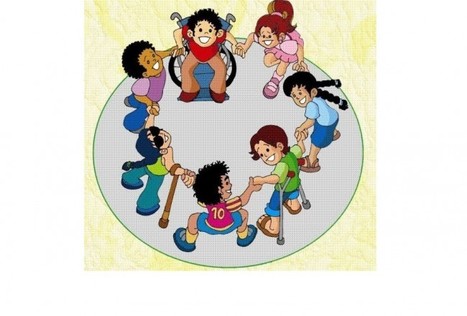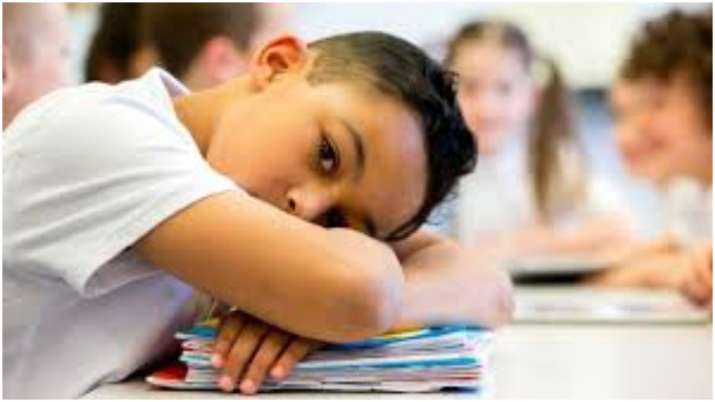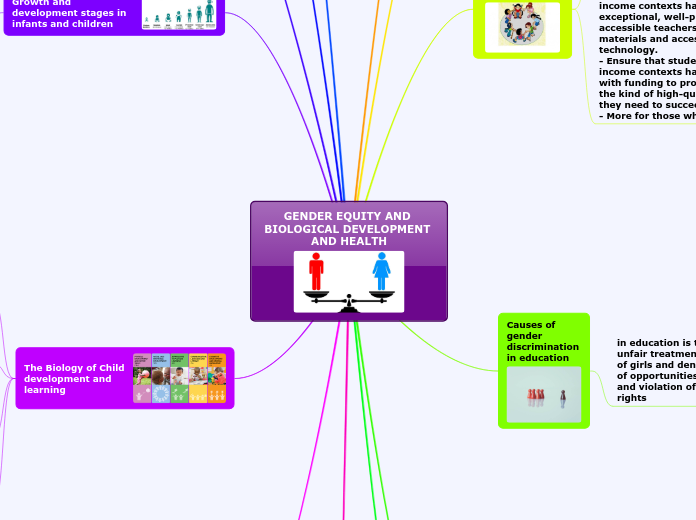GENDER EQUITY AND BIOLOGICAL DEVELOPMENT AND HEALTH

Gender definition

- Attitudes and behaviors accepted by the society as appropriate ways of being a woman or a man
-Depends on the culture, socio-economic class and time being reinforced over time by social practice
Parity
Equality
Equity

Gender parity: same proportion of girls and boys enter and complete schooling

Equality: ensure that everyone gets the same thing
Gender equality: aspiration of many international conventions to respect human rights.

Equity: fairness without bias
Gender equity: equality and justice between men and women in behavior, role, opportunity, appreciation and relationship.
Educational equality and equity

- Ensure that all students have the same access to resources
- Leveling the playing field
- Lagging students need more resources to catch up, succeed and eventually close the performance gap.
- Ensure that students from low-income contexts have access to exceptional, well-prepared and accessible teachers, up-to-date materials and access to technology.
- Ensure that students in low-income contexts have schools with funding to provide them with the kind of high-quality education they need to succeed.
- More for those who need it.
Causes of gender discrimination in education

in education is the unfair treatment of girls and denial of opportunities and violation of rights
Political factors

- Gender equality and gender equity promote peace
- Improving the women situation in terms of access to education, political representation and economic participation will improve peace in the society
Socio-economic factors

Poverty is one factor preventing children and specially girls from getting access to education
Socio-cultural factors

- Patriarchal society: these decisions about educational matters favor more boys than girls.
- Chauvinist mentality: Women are considered weak not only physically but also mentally.
- In some homes, there is a persistent gender stereotyping, gender discrimination and negative attitudes towards girl’s education.
- Some families do not pay attention to girl child.
- Education is cut short by unwanted pregnancies
- Violence (physical, sexual or psychological harm) is a barrier to access education.
- Some religions claim that women are less valuable than boys.
- In some parts of the world and in Ecuador, some women lack sufficient power.
Stakeholders to get the Gender equity

Government responsibilities
-To apply what the Ecuadorian Constitution says in terms of the right of education and non-discrimination for girls.
- To build equitable and inclusive education systems
- To consider the gender implications of how they allocate resources.
- To ensure curricula and textbooks do not promote gender bias, teacher training programs address gender issues and school facilities are according to girls ‘needs.
Parent responsibilities
Ensure your children have opportunities to go to school and provide them with affective, encouraging, and material support alike.
/role-of-principal-in-schools-3194583_FINAL-759d5ecdff4b4b4ea77bcf4eb8182823.png)
Responsibilities of schools, teachers and students
- Inclusive teaching practices and fair disciplinary rules.
- Students are responsible of ensuring their inclusion and for demanding that the right of education is equal for both boys and girls.
- The community is responsible for monitoring government, schools, parents and students to challenge stereotypes and ensure that discriminatory practices are not tolerated
The process of gender equity construction
“Gender equality in education cannot be separated as a goal from gender equality in society as a whole”
Biological development

Includes stages that start when a baby is still in the womb
The infant stage is also a time of crucial growth and development
Growth refers to increase in size, length, height and weight.
Development implies overall changes in the individual
The pre-natal stages of development
/2795073-stages-of-prenatal-development-01-5a3040f6eb4d5200362d5553.png)
germinal stage
embryonic period
fetal period
Brain development before birth

The brain develops in the third week of gestation until the end of adolescence
gene expression
impact of the environment
Growth and development stages in infants and children

Infancy is the first stage of development for children and covers the child during prenatal care and up to 1 year old

Cognition
the ability to learn and problem solve

Social interaction and emotional regulation
interacting with others and mastering self-control

Speech and Language
understanding and using language, reading and communicating

Physical skills
fine motor (finger) skills and gross motor (whole body) skills

Sensory awareness
the registration of sensory information for use(Kid sense)
The Biology of Child development and learning

Rapidity of brain development during early child-hood
Develops through dynamic interaction between underlying biological processes
The interplay of genes and environment.
Genes and environmental factors and experiences influence the child development. Neither environment nor biology alone is destiny.
The impact of stress on development
- Early psychological and social adversities beginning even during fetal development
- Immune and endocrine system could be affected by stress.
Individual differences in sensitivity to environments
Individual differences can affect in the environment of susceptible children
The Biology of adolescent development

- It is the name for the period from 10 to 20 years old where boys and girls reach adult height and weight and undergo sexual maturation.
- Changes that take place during this period are physical, intellectual, personality and social development.
Accelerated growth: boys between the age of 12 and 17, girls between the ages of 9½ years and 13½ years
- Sexual maturation or puberty begins at different ages depending on genetic and environmental factors
- A development of sexual organs in males and females and several hormone changes
The frontal lobe of the adolescents which is responsible for judgment, impulse, and control and planning are still maturing.
How health affects a child and an adolescent´s school performance
Poor sleep
Exercise

Importance of breakfast

Obesity

Asthma

Chronic health problems

